HONDA CIVIC SEDAN 2013 Owner's Manual (in English)
Manufacturer: HONDA, Model Year: 2013, Model line: CIVIC SEDAN, Model: HONDA CIVIC SEDAN 2013Pages: 368, PDF Size: 43.54 MB
Page 321 of 368

Continued319
uuIf a Tire Goes Flat uChanging a Flat Tire
Handling the Unexpected
1. Remove the wheel nuts and flat tire.
1. Remove the wheel nuts, wheel cover, and
flat tire.
2. Wipe the mounting su rfaces of the wheel
with a clean cloth.
3. Mount the compact spare tire.
4. Screw the wheel nuts un til they touch the
lips around the mounting holes, and stop
rotating.
■Replacing the Flat Tire1 Replacing the Flat Tire
Do not over tighten the wheel nuts by applying extra
torque using your foot or a pipe.
Do not attempt to forcibly pry the wheel cover off
with a screwdriver or other tool.
The wheel cover cannot be removed without first
removing the wheel nuts.
Models with wheel cover
Models with aluminum wheels
Wheel
CoverModels with wheel cover
All models
Page 322 of 368
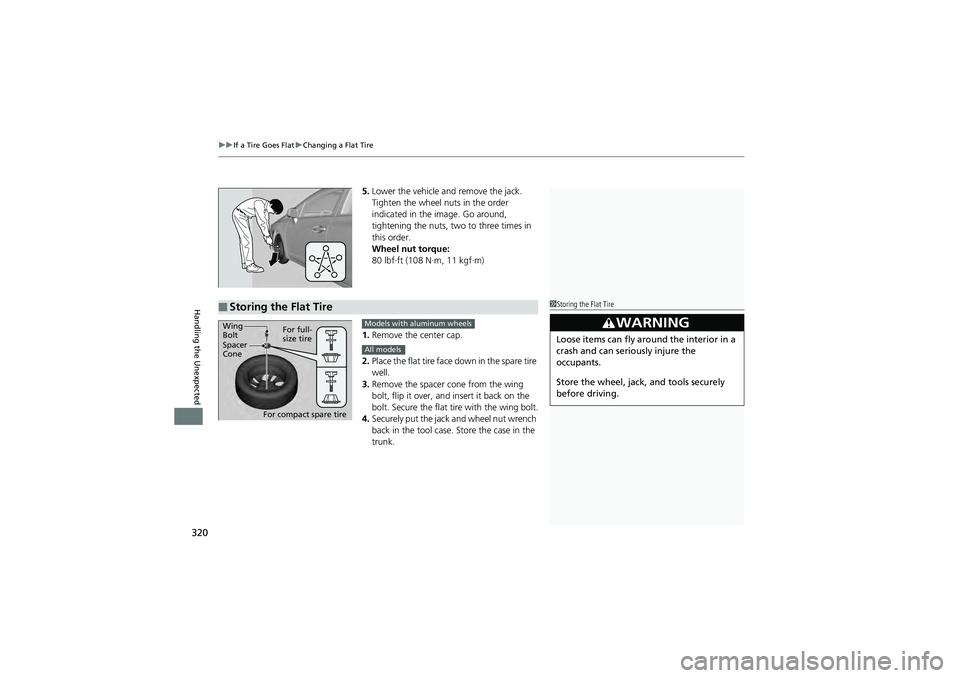
uuIf a Tire Goes Flat uChanging a Flat Tire
320
Handling the Unexpected
5. Lower the vehicle and remove the jack.
Tighten the wheel nuts in the order
indicated in the image. Go around,
tightening the nuts, two to three times in
this order.
Wheel nut torque:
80 lbf∙ft (108 N∙m, 11 kgf∙m)
1. Remove the center cap.
2. Place the flat tire face down in the spare tire
well.
3. Remove the spacer cone from the wing
bolt, flip it over, and insert it back on the
bolt. Secure the flat tire with the wing bolt.
4. Securely put the jack and wheel nut wrench
back in the tool case. Store the case in the
trunk.
■Storing the Flat Tire1 Storing the Flat Tire
3WARNING
Loose items can fly around the interior in a
crash and can seriously injure the
occupants.
Store the wheel, jack, and tools securely
before driving.Spacer
ConeWing
Bolt
For compact spare tireFor full-
size tire
Models with aluminum wheels
All models
Page 323 of 368
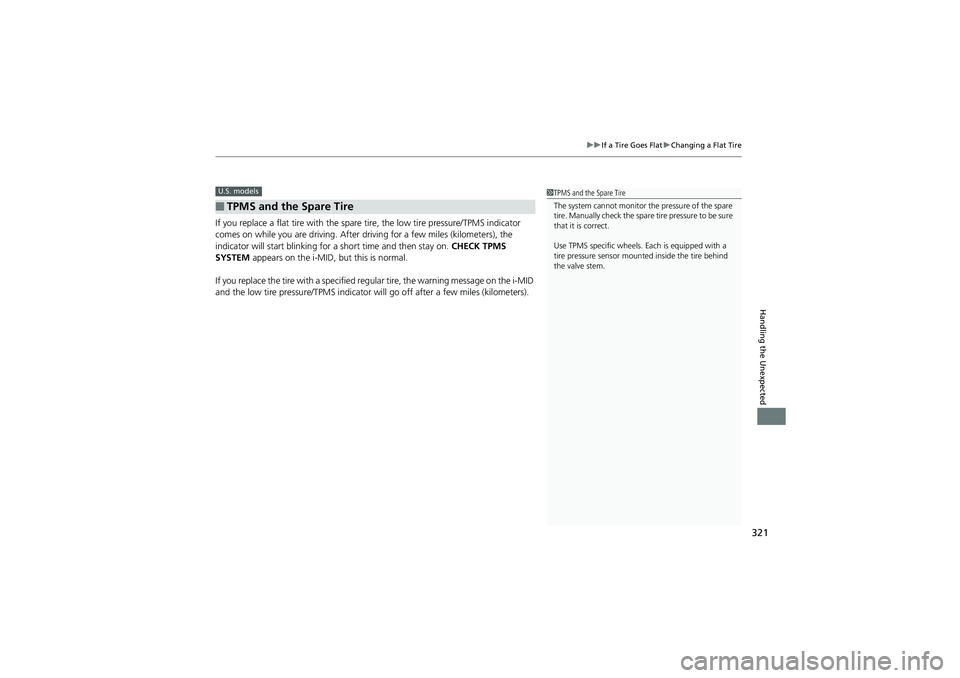
321
uuIf a Tire Goes Flat uChanging a Flat Tire
Handling the Unexpected
If you replace a flat tire with the spare tire, the low tire pressure/TPMS indicator
comes on while you are driving. After dr iving for a few miles (kilometers), the
indicator will start blinking for a short time and then stay on. CHECK TPMS
SYSTEM appears on the i-MID, but this is normal.
If you replace the tire with a specified re gular tire, the warning message on the i-MID
and the low tire pressure/TPMS indicator w ill go off after a few miles (kilometers).
■TPMS and the Spare Tire
U.S. models1TPMS and the Spare Tire
The system cannot monitor the pressure of the spare
tire. Manually check the spare tire pressure to be sure
that it is correct.
Use TPMS specific wheels. Each is equipped with a
tire pressure sensor mount ed inside the tire behind
the valve stem.
Page 324 of 368
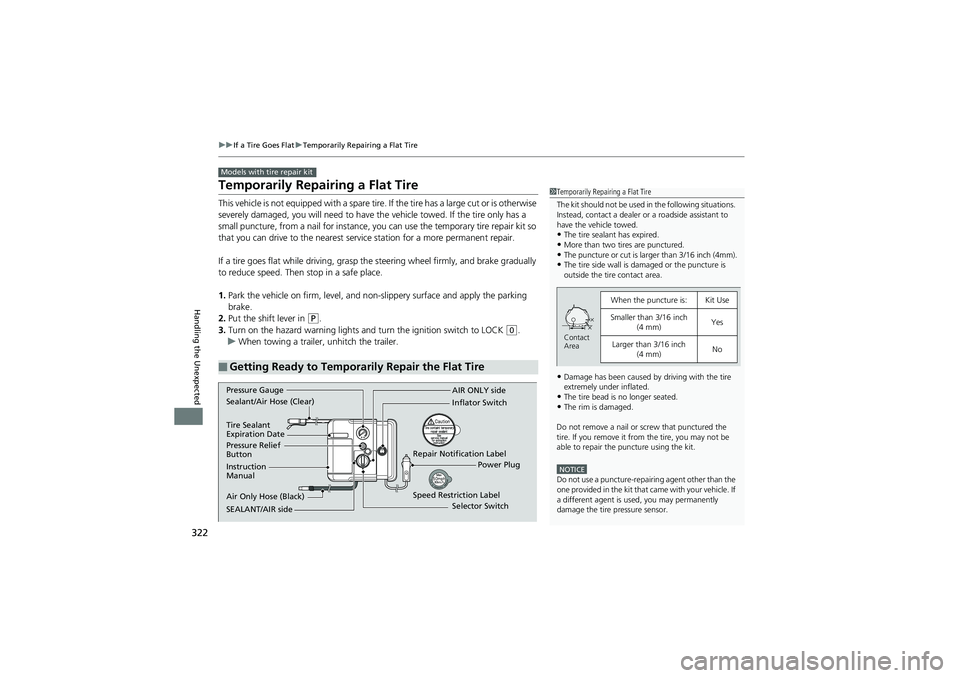
322
uuIf a Tire Goes Flat uTemporarily Repairing a Flat Tire
Handling the Unexpected
Temporarily Repairing a Flat Tire
This vehicle is not equipped with a spare tire. If the tire has a large cut or is otherwise
severely damaged, you will need to have the vehicle towed. If the tire only has a
small puncture, from a nail fo r instance, you can use the temporary tire repair kit so
that you can drive to the nearest servic e station for a more permanent repair.
If a tire goes flat while driving, grasp the steering wheel firmly, and brake gradually
to reduce speed. Then stop in a safe place.
1. Park the vehicle on firm, level, and non- slippery surface and apply the parking
brake.
2. Put the shift lever in
(P.
3. Turn on the hazard warning lights and turn the ignition switch to LOCK
(0.
u When towing a trailer, unhitch the trailer.
■Getting Ready to Temporar ily Repair the Flat Tire
Models with tire repair kit
1Temporarily Repairing a Flat Tire
The kit should not be used in the following situations.
Instead, contact a dealer or a roadside assistant to
have the vehicle towed.
•The tire sealant has expired.•More than two tires are punctured.•The puncture or cut is larger than 3/16 inch (4mm).•The tire side wall is dama ged or the puncture is
outside the tire contact area.
•Damage has been caused by driving with the tire
extremely under inflated.
•The tire bead is no longer seated.•The rim is damaged.
Do not remove a nail or screw that punctured the
tire. If you remove it from the tire, you may not be
able to repair the puncture using the kit.
NOTICEDo not use a puncture-repairing agent other than the
one provided in the kit that came with your vehicle. If
a different agent is used, you may permanently
damage the tire pressure sensor.
When the puncture is:Kit Use
Smaller than 3/16 inch
(4 mm)Yes
Larger than 3/16 inch (4 mm)No
Contact
Area
Instruction
Manual
Air Only Hose (Black) Speed Restriction Label Repair Notification Label
Pressure Relief
Button Inflator Switch
Selector Switch
SEALANT/AIR side Sealant/Air Ho se (Clear) AIR ONLY side
Power Plug
Pressure Gauge
Tire Sealant
Expiration Date
Page 325 of 368
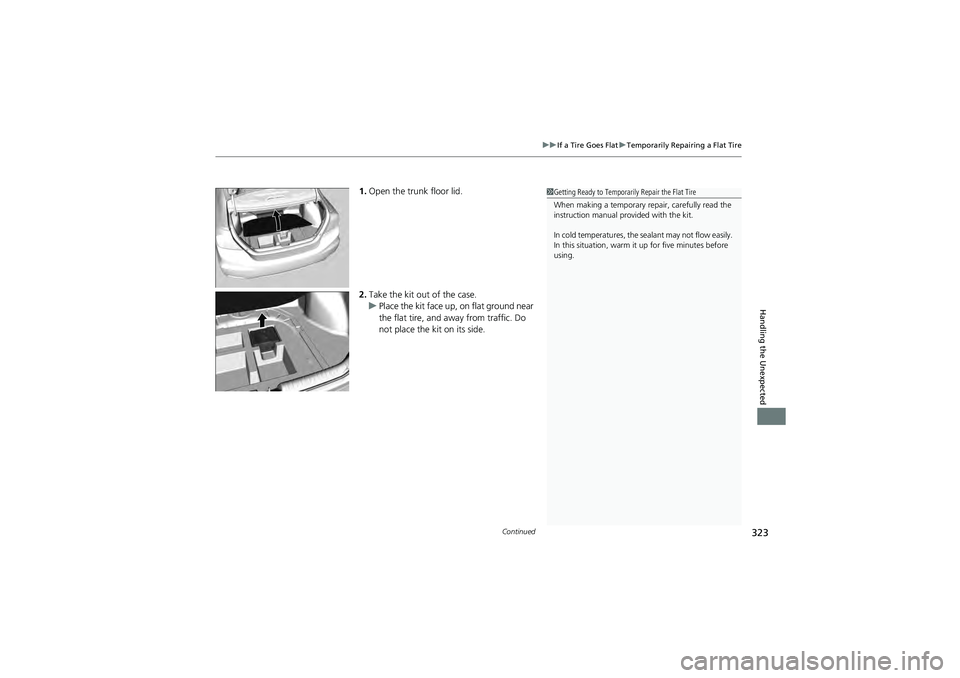
Continued323
uuIf a Tire Goes Flat uTemporarily Repairing a Flat Tire
Handling the Unexpected
1. Open the trunk floor lid.
2. Take the kit out of the case.
u Place the kit face up, on flat ground near
the flat tire, and aw ay from traffic. Do
not place the kit on its side.1 Getting Ready to Temporarily Repair the Flat Tire
When making a temporary repair, carefully read the
instruction manual provided with the kit.
In cold temperatures, the sealant may not flow easily.
In this situation, warm it up for five minutes before
using.
Page 326 of 368
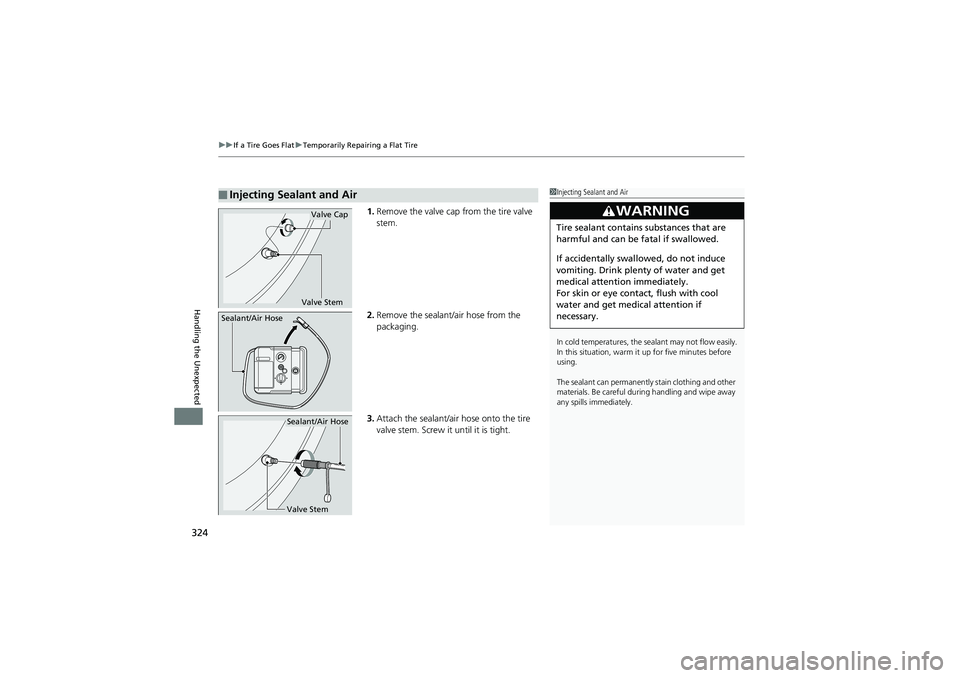
uuIf a Tire Goes Flat uTemporarily Repairing a Flat Tire
324
Handling the Unexpected
1. Remove the valve cap from the tire valve
stem.
2. Remove the sealant/air hose from the
packaging.
3. Attach the sealant/air hose onto the tire
valve stem. Screw it until it is tight.
■Injecting Sealant and Air1Injecting Sealant and Air
In cold temperatures, the sealant may not flow easily.
In this situation, warm it up for five minutes before
using.
The sealant can permanently stain clothing and other
materials. Be careful duri ng handling and wipe away
any spills immediately.
3WARNING
Tire sealant contains substances that are
harmful and can be fatal if swallowed.
If accidentally swallowed, do not induce
vomiting. Drink plenty of water and get
medical attention immediately.
For skin or eye contact, flush with cool
water and get medical attention if
necessary.
Valve Stem
Valve Cap
Sealant/Air Hose
Valve Stem
Sealant/Air Hose
Page 327 of 368
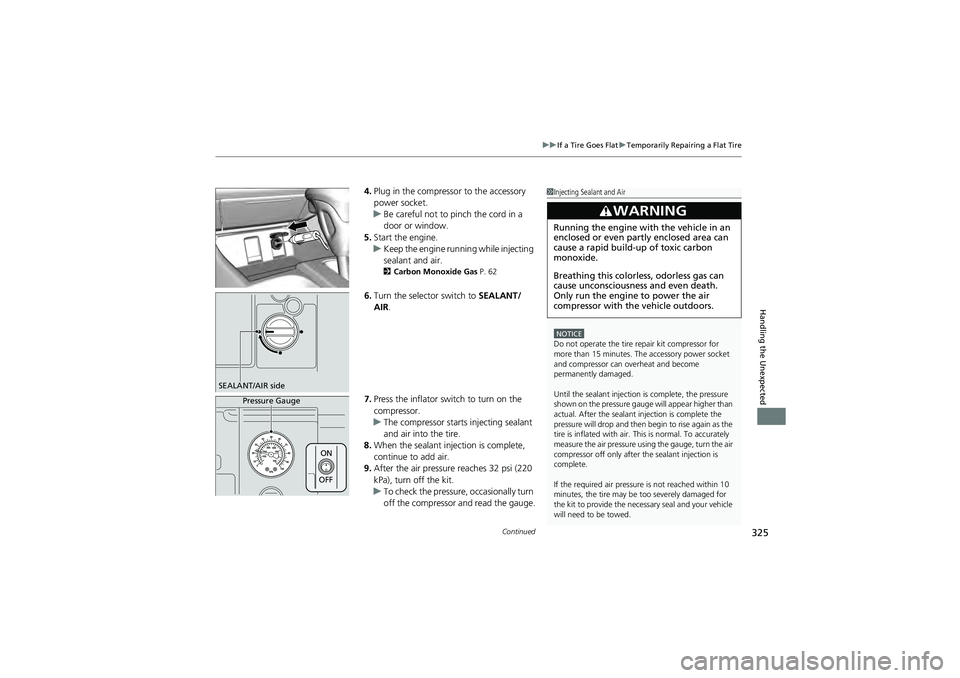
Continued325
uuIf a Tire Goes Flat uTemporarily Repairing a Flat Tire
Handling the Unexpected
4. Plug in the compresso r to the accessory
power socket.
u Be careful not to pinch the cord in a
door or window.
5. Start the engine.
u Keep the engine running while injecting
sealant and air.
2 Carbon Monoxide Gas P. 62
6.Turn the selector switch to SEALANT/
AIR .
7. Press the inflator switch to turn on the
compressor.
u The compressor starts injecting sealant
and air into the tire.
8. When the sealant injection is complete,
continue to add air.
9. After the air pressure reaches 32 psi (220
kPa), turn off the kit.
u To check the pressure , occasionally turn
off the compressor and read the gauge.
1 Injecting Sealant and Air
NOTICEDo not operate the tire re pair kit compressor for
more than 15 minutes. The accessory power socket
and compressor can ov erheat and become
permanently damaged.
Until the sealant injection is complete, the pressure
shown on the pressure gauge will appear higher than
actual. After the sealant injection is complete the
pressure will drop and then begin to rise again as the
tire is inflated with air. Th is is normal. To accurately
measure the air pressure using the gauge, turn the air
compressor off only after the sealant injection is
complete.
If the required air pressure is not reached within 10
minutes, the tire may be too severely damaged for
the kit to provide the necessary seal and your vehicle
will need to be towed.
3WARNING
Running the engine with the vehicle in an
enclosed or even partly enclosed area can
cause a rapid build-up of toxic carbon
monoxide.
Breathing this colorless, odorless gas can
cause unconsciousness and even death.
Only run the engine to power the air
compressor with the vehicle outdoors.
SEALANT/AIR side
Pressure Gauge
ON
OFF
Page 328 of 368
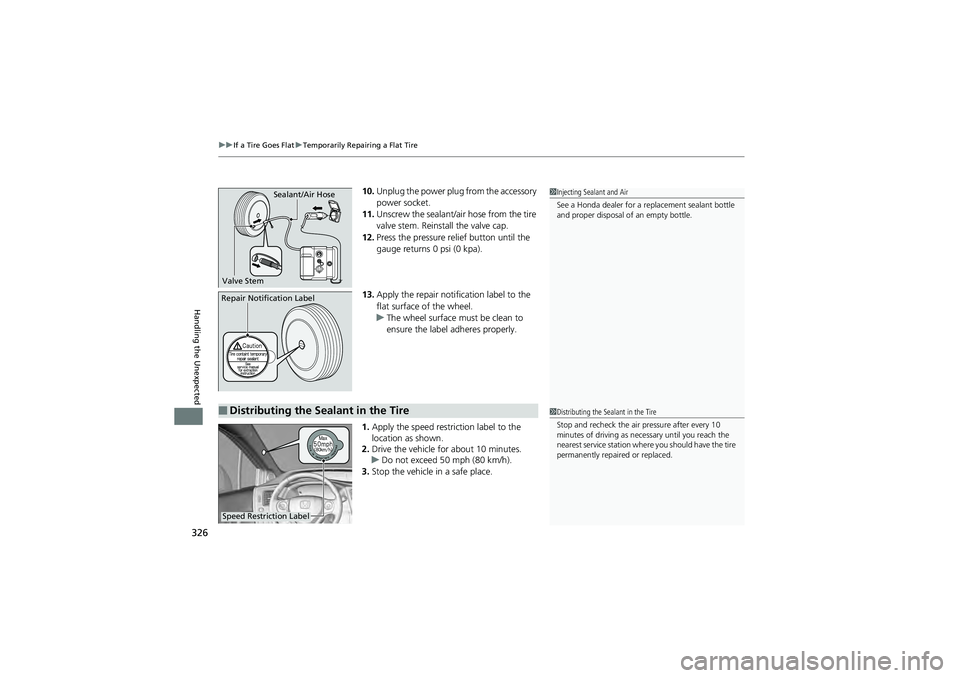
uuIf a Tire Goes Flat uTemporarily Repairing a Flat Tire
326
Handling the Unexpected
10. Unplug the power plug from the accessory
power socket.
11. Unscrew the sealant/ai r hose from the tire
valve stem. Reinstall the valve cap.
12. Press the pressure reli ef button until the
gauge returns 0 psi (0 kpa).
13. Apply the repair notification label to the
flat surface of the wheel.
u The wheel surface must be clean to
ensure the label adheres properly.
1. Apply the speed restriction label to the
location as shown.
2. Drive the vehicle for about 10 minutes.
u Do not exceed 50 mph (80 km/h).
3. Stop the vehicle in a safe place.1Injecting Sealant and Air
See a Honda dealer for a re placement sealant bottle
and proper disposal of an empty bottle.Sealant/Air Hose
Valve Stem
Repair Notification Label
■Distributing the Sealant in the Tire1 Distributing the Sealant in the Tire
Stop and recheck the air pressure after every 10
minutes of driving as necessary until you reach the
nearest service station where you should have the tire
permanently repaired or replaced.
Speed Restriction Label
Page 329 of 368
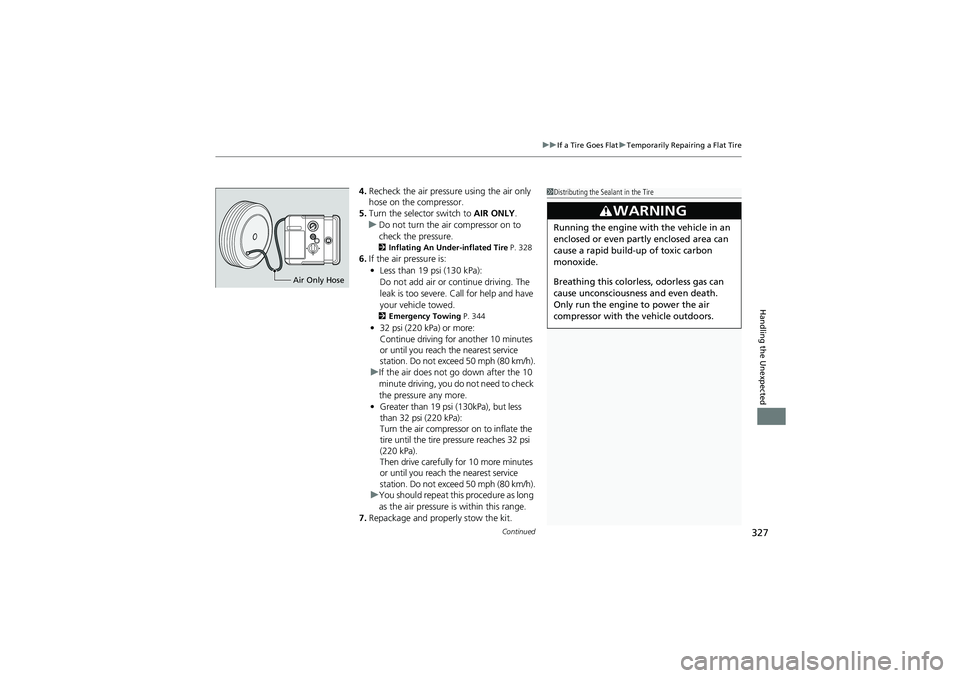
Continued327
uuIf a Tire Goes Flat uTemporarily Repairing a Flat Tire
Handling the Unexpected
4. Recheck the air pressure using the air only
hose on the compressor.
5. Turn the selector switch to AIR ONLY.
u Do not turn the ai r compressor on to
check the pressure.
2 Inflating An Under-inflated Tire P. 328
6.If the air pressure is:
• Less than 19 psi (130 kPa):
Do not add air or continue driving. The
leak is too severe. Call for help and have
your vehicle towed.
2 Emergency Towing P. 344
•32 psi (220 kPa) or more:
Continue driving for another 10 minutes
or until you reach the nearest service
station. Do not exce ed 50 mph (80 km/h).
u If the air does not go down after the 10
minute driving, you do not need to check
the pressure any more.
• Greater than 19 ps i (130kPa), but less
than 32 psi (220 kPa):
Turn the air compressor on to inflate the
tire until the tire pressure reaches 32 psi
(220 kPa).
Then drive carefully for 10 more minutes
or until you reach the nearest service
station. Do not exce ed 50 mph (80 km/h).
u You should repeat this procedure as long
as the air pressure is within this range.
7. Repackage and properly stow the kit.
1Distributing the Sealant in the Tire
3WARNING
Running the engine with the vehicle in an
enclosed or even partly enclosed area can
cause a rapid build-up of toxic carbon
monoxide.
Breathing this colorless, odorless gas can
cause unconsciousness and even death.
Only run the engine to power the air
compressor with the vehicle outdoors.
Air Only Hose
Page 330 of 368
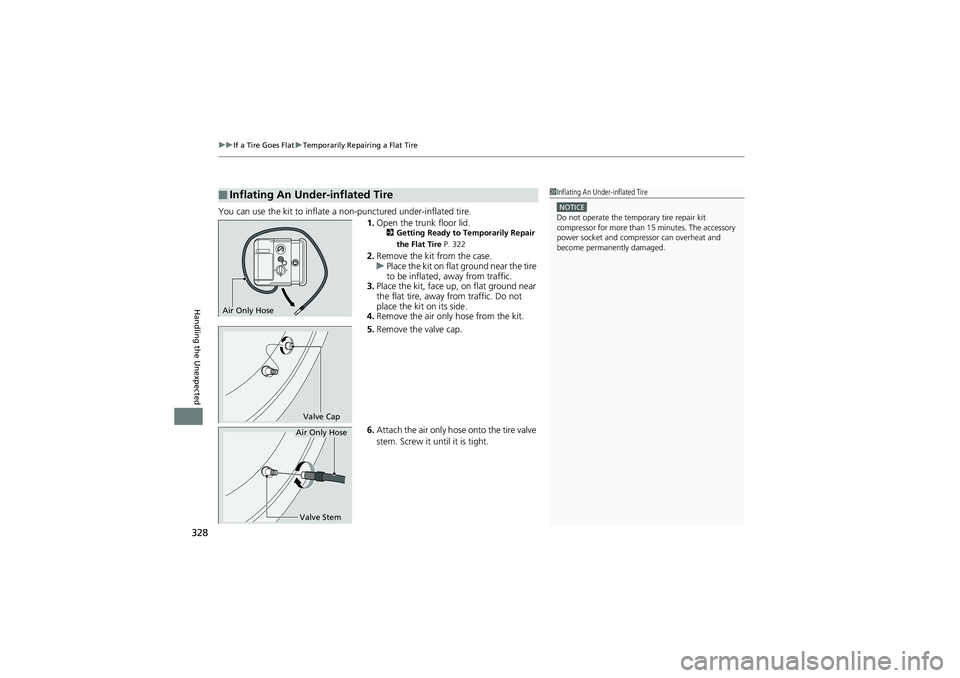
uuIf a Tire Goes Flat uTemporarily Repairing a Flat Tire
328
Handling the Unexpected
You can use the kit to inflate a non-punctured under-inflated tire.
1.Open the trunk floor lid.
2 Getting Ready to Te mporarily Repair
the Flat Tire P. 322
2.Remove the kit from the case.
u Place the kit on flat ground near the tire
to be inflated, away from traffic.
3. Place the kit, face up, on flat ground near
the flat tire, away from traffic. Do not
place the kit on its side.
4. Remove the air only hose from the kit.
5. Remove the valve cap.
6. Attach the air only hose onto the tire valve
stem. Screw it until it is tight.
■Inflating An Under-inflated Tire1Inflating An Under-inflated Tire
NOTICEDo not operate the tem porary tire repair kit
compressor for more than 15 minutes. The accessory
power socket and compressor can overheat and
become permanently damaged.
Air Only Hose
Valve Cap
Valve Stem
Air Only Hose